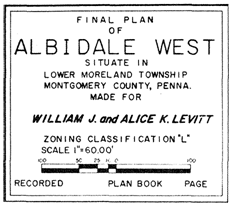 Architectural and cultural historians for decades have been tuned into the significance of the sprawling Postwar suburbs built by Levitt & Sons bearing the family firm’s name. Recent research into other Levitt developments like Belair in Bowie in the Washington, D.C., suburbs has expanded our understanding of the Levitts’ impact on modern cultural landscapes and in shaping American homeownership. Last week while doing some fieldwork in the Philadelphia suburbs I encountered a 1960s subdivision planned by firm president William J. Levitt (1907-1994).
Architectural and cultural historians for decades have been tuned into the significance of the sprawling Postwar suburbs built by Levitt & Sons bearing the family firm’s name. Recent research into other Levitt developments like Belair in Bowie in the Washington, D.C., suburbs has expanded our understanding of the Levitts’ impact on modern cultural landscapes and in shaping American homeownership. Last week while doing some fieldwork in the Philadelphia suburbs I encountered a 1960s subdivision planned by firm president William J. Levitt (1907-1994).
Named Albidale — Al (for Alice K. Levitt) and bi (for Bill Levitt) plus the rustic-sounding dale — the development included two tracts culled from a large 600-acre horse farm and steeplechase track assembled by Philadelphia philanthropist George W. Elkins (1886-1954) begun in the 1920s. Albidale’s core, dubbed Albidale West by Levitt, includes a cluster of stone homes Elkins built in 1936 for his employees and a pair of eighteenth century stone houses that once were part of farms Elkins bought in the 1920s and 1930s for his expansive Justa Farm complex.

Albidale West Plat. Montgomery County Land Records.
Earlier this year a new book on Pennsylvania’s Levittown, Second Suburb, was published and I have now moved my copy to the top of my reading list. The Levitts were fresh in my mind before I did last week’s fieldwork because I had just read Jamie Jacobs’ chapter on Belair in Richard Longstreth’s new book, Housing Washington. Jacobs’ 2005 dissertation has a valuable discussion of suburban real estate marketing techniques that I am using in my work on Silver Spring’s 1939 World’s Fair Home. Two things intrigue me about Levitt and they are beyond the scope of my current research project: 1) Levitt did not scrape away all evidence of the 18th, 19th, and early 20th centuries to make way for his development; and, 2) Levitt and his wife briefly lived in one of the Elkins houses. Continue reading
